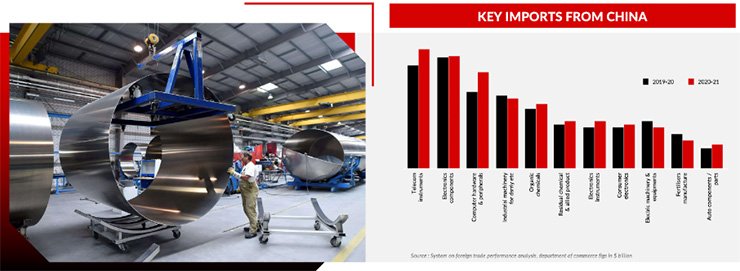How Quality Control Orders Can Restrict Imports from China to India
Across multiple projects in India, we have encountered the topic of Quality Control Orders (QCO). For example, QCO become relevant when American or European producers plan to set up an end assembly in India, but would like to import from existing subcomponent plants in China or other markets outside of India. Once a QCO comes into effect for a product, it prescribes that imports to India must be certified with the “ISI mark” from the Indian Standards Institute (ISI). In our latest article, we explain the problem in detail, show up parts that are currently affected and give an outline which parts will be affected in the future.
India has introduced Quality Control Orders (QCOs) in 2016 to eliminate sub grade imports by demanding certification under ISI schemes. Due to the recent expansion of the scope of affected parts, quality control orders have reduced Chinese imports that have surged during and after Covid. As a second result, quality control orders have enhanced Indian exports to western markets over the last years. This is in line with the “Make in India” initiative, which promotes quality manufacturing to transform India into a global manufacturing hub.
However, the wider use quality control orders has also resulted in a shortage of raw materials, affecting Indian businesses that are seeking for more time to adapt.

While imports from China have stabilized from 2020 to 2021, Quality Control Orders have resulted in potential supply shortages for Indian Businesses.
What is ISI Mark?
The ISI Mark is a standardization mark issued by the Bureau of Indian Standards (BIS) to certify that the products conform to the minimum quality standards for industrial products in India since 1950. Presence of ISI certification mark, known as Standard Mark, on a product is an assurance of conformity to the specifications. The conformity is ensured by regular surveillance of the licensee’s performance by surprise inspections and testing of samples, drawn both from the market and factory. The manufacturer is permitted to self-certify the licensed products after ascertaining its conformity to the Standard. This ISI certification lasts for only a year.

Characteristic ISI Mark and Logo of the Bureau of Indian Standards issuing the ISI Mark.
After the inception of the QCO, none can manufacture, import, distribute, sell, hire, lease, store or exhibit for sale any product(s) covered under the QCO without a ISI mark except under a valid certification from BIS. QCOs are equally applicable to Indian as well as foreign manufacturers, thus consumers are assured of the quality of such products manufactured in India as well as imported to the country.
Is my product affected?
Affected products fall under two major schemes. Under Scheme I (ISI mark), the ISI mark is compulsory, besides a laboratory test for your product, you will need a manufacturing site audit by BIS inspectors. Under Scheme II (Compulsory Certification Scheme – CRS), your products just need to pass laboratory tests and no plant audit is necessary.
Products affected by Scheme I (ISI mark) are often related to heavy industry and food industry. Examples:
- PVC insulated cables for working voltages up to and including 1100V
- Multi-Purpose dry batteries
- Automotive vehicles-Pneumatic tyres for passenger car vehicles– Diagonal and radial ply
- Cold reduced carbon steel sheets and strips Part 1 Cold Forming and Drawing Purpose
- Stainless Steel Wires
- Room Air Conditioners
- Diagnostic Medical X-Ray Equipment
- Milk-powder
- Milk- cereal Based Complementary foods
A complete list of all 415 items of Scheme I (ISI Mark) can be found under this link to Scheme I products.
Products affected by Scheme II (Compulsory Certification Scheme – CRS) are mainly related to Electronics and IT goods. Examples:
- Electronic Games (Video)
- Plasma/ LCD/LED Televisions of screen size 32″ & above
- Microwave Ovens
- Printers, Plotters
- DC or AC Supplied Electronic Control gear for LED Modules
- CCTV cameras
A full list of all 73 items thus far can be found under this link to Scheme II products.
How is ISI mark acquired?
Acquiring ISI mark requires passing various tests and inspections to certify the product meets appropriate Indian standards.
- Application – A manufacturer is expected to submit an application under ‘Normal Procedure’ or ‘Simplified Procedure’. The authorised BIS officer will conduct a preliminary assessment of the application together with all the documents. Under the Simplified Procedure, applicant is required to apply with the Test report/s from a BIS accredited laboratory whereas under the Normal Procedure, applicant can apply without the Test report/s from a BIS accredited laboratory.
The list of BIS recognized third party testing labs can be found here. - Preliminary Inspection – An on-site factory inspection will be conducted and BIS grants a licence by assessing the manufacturing infrastructure, production process, quality control and testing capabilities. Detailed examination including factory layout, quality control parameters, staff details, testing & manufacturing equipment details, process flow, etc will be physically checked. For Scheme-I (ISI Mark) site inspection is mandatory for every product. Under Scheme II (Compulsory Registration Scheme – CRS), there is no need for site inspection. All schemes can be found here.
- In-house lab testing facility – Under the Simplified Procedure, it is compulsory to have an in-house lab testing facility. Under the Normal Procedure, if a BIS accredited lab is not available for the relevant Standard, then an in-house lab facility becomes mandatory.
- Drawing of sample(s) – Under the Simplified Procedure, sample(s) are drawn by the Inspector for independent testing by a BIS approved lab. The conformity of the product to its relevant Standard is established through the BIS approved Test report (sample drawn by the Inspector). Under the Normal Procedure, samples may or may not be drawn.
- Adherence to Scheme of Testing and payment of Marking Fee – Applicant has to adhere to the Scheme of testing and pay the marking fee.
- Grant of License (GoL) – On successful factory inspection and satisfactory test report, the manufacturer will be eligible to get CM/L number (Central Mark License) in order to use the ISI mark on each product or the package. License granted under ISI marking scheme is valid for 1 year and can be further renewed by filing the renewal application and paying the prescribed fee. In case BIS Certification is mandatory on a product and manufacturers, importers and sellers enter the Indian market without a BIS licence, they will be penalised, and the Bureau has the right to revoke their licence in accordance with the BIS Act.

Normal vs simplified certification process
Upcoming Quality Control Orders for further products
Having recently placed a greater importance on quality of goods, there are upcoming QCOs to further strengthen it, with implementation dates from 2023-2027.

Examples of upcoming Quality Control Orders:
- Automotive Wheel rims (December 22, 2023),
- Household refrigerating appliances (January 1, 2024) or
- Digital Television Receiver for Satellite Broadcast Transmission (April 26, 2025).
A full list of all currently known 89 items can be found under this link.


